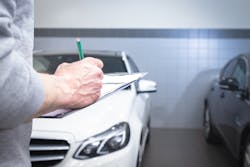I believe all have had an opportunity to review their performance for 2021, so now is the perfect time to do a little homework and look back at some key focus areas for 2022 as well. I would like to review five categories: Sales per RO, sources of work, severity breakdown, touch time, and paint hours per RO. These five areas will show you where to focus improvement efforts and how to bring sustainability to your business.
Sales per RO
Sales per RO should be looked at in a couple of different ways. First, look at how consistent the damage appraisers in your collision center are between each other. The more consistent they are, the more profitable the shop will become. A great way to build consistency is to have your appraisers review each other’s appraisals to identify the differences.
Consistency between your sources of work is another way to review sales per RO. Profitability is lost when one or more sources of work are below your average sales per RO. I have seen variances of $1,000 - $2,000 between different sources of work, which is concerning as vehicles can only be repaired one way and costs should parallel.
Sources of work
A quick review of your sources of work will reveal the percentage you are capturing from each source. Ideally, each source should average 15 percent or less to keep your business sustainable. Anything over 15 percent could affect profitability if you were to lose that business. Anything over 25 percent puts you in a dangerous situation if that source of work was lost.
A look at your annual net profit percentage will show you how much a loss of work source will affect you. In most cases, a loss of 25 percent will put a business in the red. Adding sources of work to reduce the effect of one source will build sustainability in your business.
Severity breakdown
I like looking at severity breakdown more from a production standpoint than profitability. However, an improvement in production always improves profitability. I primarily look at two severity categories: $0 - $1,500 and $1,500 - $3,000.
First, I look at them individually, then together. If either of them is over 25 percent, I look at opportunities for fast-track repairs, and if they are both over 25 percent and average 50 percent or more collectively, I recommend the shop focus' on developing a fast-track operation. When half of your repairs are below $3,000, a fast-track operation can greatly improve production in those repairs.
This type of operation should be separated from the main repair area so smaller repairs do not get mixed in with heavier repairs and bog down your process. The bonus is improving production on half of your repairs reduces your overall cycle time.
Touch time
In March 2021, ABRN published my article, "Touch time drives shop profitability", in which I described with great detail how touch time affects a collision center. Most often, low touch time is caused by poor scheduling, weak damage appraisal documentation, or a little bit of both. This is where consistency in sales per RO, coupled with a complete disassembly, can help you capture all the needed repairs upfront.
Scheduling -- along with a fast-track repair operation -- is another key component to improving touch time. If you schedule your repairs this way every day, you can move up to 50 percent of your work through the shop quickly and boost your overall touch time.
Paint hours per RO
Paint hours per RO is another area where consistency makes a difference. When reviewing your sales per RO and severity breakdown, pay close attention to the paint hours recorded on repair orders. I have seen the average paint hours per repair order fluctuate two to three hours between damage appraisers and sources of work.
This is troubling to me since we can only repair a vehicle one way, which leads me to believe that paint work is being performed without reimbursement. When paint processes are performed without billing, the sale of the products consumed are lost as well, which affects overall profitability. Standardizing your paint processes by reviewing procedure pages and repair methods is the key to improving your paint hours per RO and business sustainability.
I didn’t give you a lot of homework. I’ve just asked you to review five important things. I hope you can see how performing a review of these key focus areas can improve your business.
Some of the items you will be able to handle quickly while others will take some time to implement corrective actions. I suggest you involve your team and start with something you can improve on today. Later, set timelines and develop strategies to work on the other focus areas.
Improving your business is very rewarding, and these actions will help you establish sustainability in your operations and create the profitability you need to overcome the challenges we face in today’s collision industry. I wish you the best of luck in 2022, and I look forward to sharing five more things for you to review next year.



